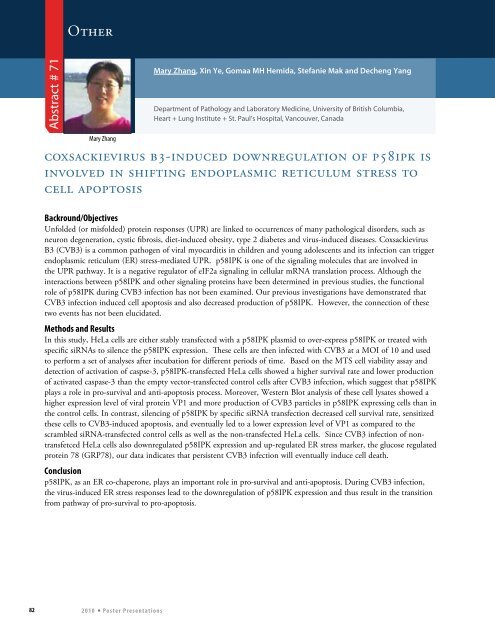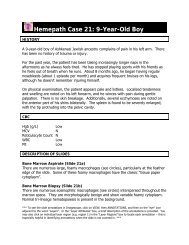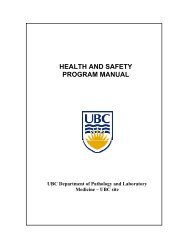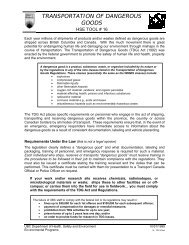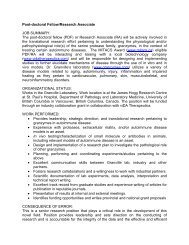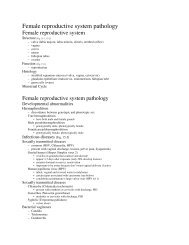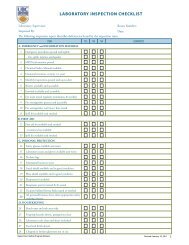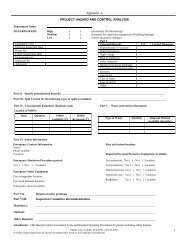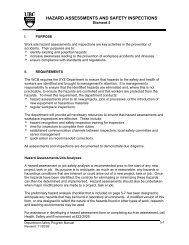Oral Presentations - Pathology and Laboratory Medicine - University ...
Oral Presentations - Pathology and Laboratory Medicine - University ...
Oral Presentations - Pathology and Laboratory Medicine - University ...
Create successful ePaper yourself
Turn your PDF publications into a flip-book with our unique Google optimized e-Paper software.
OtherAbstract # 71Mary Zhang, Xin Ye, Gomaa MH Hemida, Stefanie Mak <strong>and</strong> Decheng YangDepartment of <strong>Pathology</strong> <strong>and</strong> <strong>Laboratory</strong> <strong>Medicine</strong>, <strong>University</strong> of British Columbia,Heart + Lung Institute + St. Paul’s Hospital, Vancouver, CanadaMary Zhangcoxsackievirus b3-induced downregulation of p58ipk isinvolved in shifting endoplasmic reticulum stress tocell apoptosisBackround/ObjectivesUnfolded (or misfolded) protein responses (UPR) are linked to occurrences of many pathological disorders, such asneuron degeneration, cystic fibrosis, diet-induced obesity, type 2 diabetes <strong>and</strong> virus-induced diseases. CoxsackievirusB3 (CVB3) is a common pathogen of viral myocarditis in children <strong>and</strong> young adolescents <strong>and</strong> its infection can triggerendoplasmic reticulum (ER) stress-mediated UPR. p58IPK is one of the signaling molecules that are involved inthe UPR pathway. It is a negative regulator of eIF2a signaling in cellular mRNA translation process. Although theinteractions between p58IPK <strong>and</strong> other signaling proteins have been determined in previous studies, the functionalrole of p58IPK during CVB3 infection has not been examined. Our previous investigations have demonstrated thatCVB3 infection induced cell apoptosis <strong>and</strong> also decreased production of p58IPK. However, the connection of thesetwo events has not been elucidated.Methods <strong>and</strong> ResultsIn this study, HeLa cells are either stably transfected with a p58IPK plasmid to over-express p58IPK or treated withspecific siRNAs to silence the p58IPK expression. These cells are then infected with CVB3 at a MOI of 10 <strong>and</strong> usedto perform a set of analyses after incubation for different periods of time. Based on the MTS cell viability assay <strong>and</strong>detection of activation of caspse-3, p58IPK-transfected HeLa cells showed a higher survival rate <strong>and</strong> lower productionof activated caspase-3 than the empty vector-transfected control cells after CVB3 infection, which suggest that p58IPKplays a role in pro-survival <strong>and</strong> anti-apoptosis process. Moreover, Western Blot analysis of these cell lysates showed ahigher expression level of viral protein VP1 <strong>and</strong> more production of CVB3 particles in p58IPK expressing cells than inthe control cells. In contrast, silencing of p58IPK by specific siRNA transfection decreased cell survival rate, sensitizedthese cells to CVB3-induced apoptosis, <strong>and</strong> eventually led to a lower expression level of VP1 as compared to thescrambled siRNA-transfected control cells as well as the non-transfected HeLa cells. Since CVB3 infection of nontransfetcedHeLa cells also downregulated p58IPK expression <strong>and</strong> up-regulated ER stress marker, the glucose regulatedprotein 78 (GRP78), our data indicates that persistent CVB3 infection will eventually induce cell death.Conclusionp58IPK, as an ER co-chaperone, plays an important role in pro-survival <strong>and</strong> anti-apoptosis. During CVB3 infection,the virus-induced ER stress responses lead to the downregulation of p58IPK expression <strong>and</strong> thus result in the transitionfrom pathway of pro-survival to pro-apoptosis.82 2 0 1 0 * P o s t e r P r e s e n t a t i o n s


